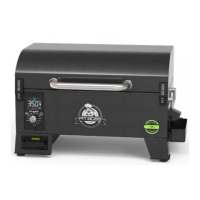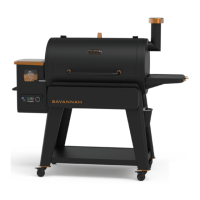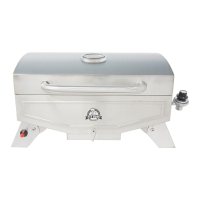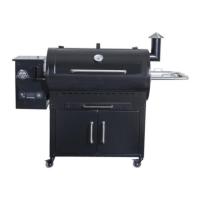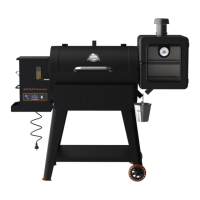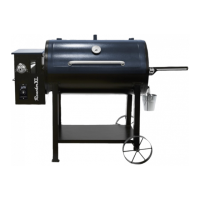1716
These clean-burning barbecue wood pellets generate about 8200 BTU’s per pound with very little ash, a low moisture content
(5-7%), and are carbon neutral. Barbecue wood pellets are produced by pure raw material (sawdust) being pulverized with a
hammer-mill, and the material is pushed through a die with pressure. As the pellet is forced through the die, it is cut, cooled,
screened, vacuumed, and then bagged for consumer use. Check with your local dealer for flavors available in your area.
Rich, smoky bacon-like flavor. Considered the
“Kings of the Woods”.
Slightly sweet, but also tart.
Gives a rosy tint to light meals.
Strong, tangy, spicy flavor.
Think Tex-Mex cuisine.
Strong, sweet smoke with aromatic tang.
Perfect for red meats.
Smoky, mld sweetness flavor
Hghly recommended for bakng
Perfect blend of sweet, savory, and tart.
Used by many professional grillers.
Sweet and savory flavor.
Bold, buttery and smooth flavor.
Sweet and earthy flavor. Alder, Maple and Pine Blend.
Rich and smokey flavor.
Cherry, Apple and Maple Blend.
Pecan , Hickory and Mesquite Blend.
NOTE: Always store wood pellets in a dry area. Avoid any contact or exposure to moisture will result in lower heat
output or cause the pellets to swell and break apart. Use a moisture proof, resealable tub or bucket for proper storage.
Air Intake Vent Every 5-6 Grill Sessions Dust, Scrub Pad & Soapy Water
Meat Probe After Each Grill Session Scrub Pad & Soapy Water
Grill probe Every 2-3 Grill Sessions Scrub Pad & Soapy Water
Smoking and grilling styles of cooking can give you different results based on time and temperature. For best results, keep a
record of what you cooked, at what temperature, how long you cooked for, and the results. Adjust to your taste for the next
time. Practice makes perfect. The culinary art of hot smoking refers to longer cooking times, but results in more natural wood
flavor (and a sought-after
smoke ring
) on your meats. Higher cooking temperatures result in a shorter cooking time, locking in
less smoke flavor.
TIP: For best results, allow time for meats to rest after cooking. This allows the natural juices to migrate back into
the meat fiber, giving a much juicer, flavorful cut. Resting times can be as little as 3 minutes and up to 60 minutes,
depending on the size of the protein.
(Very Low)
(Low)
(Medium)
/
(Medium/High)
(High)
Temp Range 93-135°C / 199-275°F 135-162°C / 275-323°F 162-190°C / 323-374°F 190-232°C / 374-449°F 232-260°C / 449-500°F
Size Rare - 54°C / 130°F Medium - 60°C / 140°F Well Done - 77°C / 170°F
Turkey
(whole)
4.5-5.0 kg / 10-11 lbs.
5.3-6.4 kg / 12-14 lbs.
6.8-7.7 kg / 15-17 lbs.
8.2-10.0 kg / 18-22 lbs.
10.4-11.3 kg / 23-25 lbs.
Grill 90 - 120 minutes
Grill 110 - 140 minutes
Grill 130 - 160 minutes
Grill 140 - 170 minutes
Grill 150 - 180 minutes
Chicken
(whole)
1.36-2.26 kg / 3-5 lbs. Grill 1 - 1.5 hours
Drumsticks, Breasts 0.45 - 0.86 kg / 1 - 1½ lbs. Grill 30-60 minutes
Small Game Birds 0.45 - 0.86 kg / 1 - 1½ lbs. Grill 30-45 minutes
Duck 1.36-2.26 kg / 3-5 lbs. Roast or grill 2 - 2.5 hours
Precooked to Reheat
60°C / 140°F
Medium
66°C / 150°F
Well Done
71°C / 160°F
Ham
(Fully Cooked &
Boneless Portion,
Smoked Picnic
Whole & Bone-In)
2.5 cm / 1"
1.36-1.81 kg / 3-4 lbs.
1.81-2.72 kg / 4-6 lbs.
2.26-3.62 kg / 5-8 lbs.
4.53-5.44 kg / 10-12 lbs.
12 minutes
50 minutes - 1 hour
1 - 2 hours
1 - 2½ hours
2 - 2¾ hours
Loin Roast 1.36-1.81 kg / 3 - 4 lbs. 1 - 2 hours 2 - 3 hours
Rib Crown Roast 1.81-2.26 kg / 4 - 5 lbs. 1½ - 2 hours 2 - 3 hours
Chop
(loin, rib)
1.9-2.5 cm / ¾" - 1"
3.1-3.9 cm / 1¼" - 1½"
10 - 12 minutes
14 - 18 minutes
Tenderloin 1.9-2.5 cm / ¾" - 1" 20 - 30 minutes 30 - 45 minutes
Loin Roast
(boneless)
1.36-2.26 kg / 3-5 lbs. 1¼ - 1¾ hours 1¾ - 2½ hours
Boston Butt
(Pork Shoulder)
3.62-4.53 kg / 8-10 lbs. 93 - 98°C / 200 - 210°F
Internal Temperature
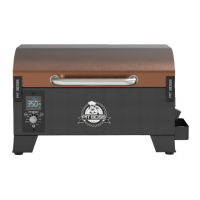
